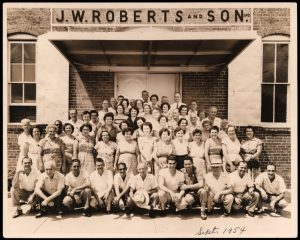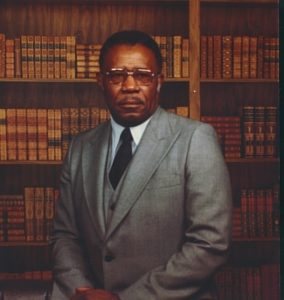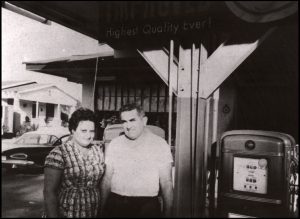This post was guest authored by Stephanie Mackin, Archives Librarian in Special Collections at the Tampa Library
Once a vibrant community in West Tampa, Roberts City was notable for its residents, bustling businesses, and nationally recognized athletes. Today, it is remembered only through historical markers, cherished memories of former residents, and the archives they preserved.
Like many stories in Tampa, Roberts City begins with the establishment of a cigar factory. In 1893, the Ellinger cigar factory relocated from Key West to the rapidly growing “Cigar Capital” of Tampa. Julius Ellinger opened the first brick cigar factory in West Tampa, located on Garcia Avenue and Green Street along the banks of the Hillsborough River. This prompted the surrounding settlement of nearly 400 cigar workers to be briefly known as Ellinger City. After Ellinger died in 1902, the company moved across the river to Ybor City, and the building remained empty for many years. In 1909, another cigar manufacturer, J.W. Roberts & Sons, made the brick building their home. This revival of commerce spurred the settlement, which spanned from the northern and eastern banks of the Hillsborough River to North Boulevard on the west and Cass Street on the south, to be aptly renamed Roberts City. [1]

The remarkable aspect of Roberts City was its close-knit community. Families of Cuban, Italian, Spanish, and African descent lived and worked together, establishing grocery stores, fish markets, bakeries, pharmacies, and significant historical sites like the Clara Frye Hospital and the Buena Vista Hotel. In 1915, the National Association for the Advancement of Colored People (NAACP) established a chapter in Roberts City, following the encouragement of several citizens including, Marion E. Rogers, the grandmother of Robert W. Saunders. [2] Saunders, who would later become the field director for the Florida NAACP and a distinguished leader in Tampa, was born and raised in Roberts City on Dorsey and Garcia Avenues. Reflecting on his childhood in Roberts City, he recalled the strong bonds that connected the community members saying, “We were raised up, the Fontes, the Contes, the Matassinis, the Mirabellas, the Rogers, you name it. We were all raised up together.” [3]

The Roberts City collection housed at the USF Tampa Library’s Special Collections department offers a firsthand account of life in Roberts City through the recollections of Mr. George Lopez. He recalls his youth, attending MacFarlane Elementary School, working as a paperboy at the Rittencliff Cafeteria, and, notably, watching his older brother Tony “Half Pint” Lopez train for boxing matches at the Buena Vista Hotel gym. “I remember my mom suffering every time he would box,” he reflects. While proud of his brother’s success as a national featherweight contender, George recognizes a stark difference between the “hungry fighters” and those who were “strictly business.” He explains that despite Tony’s talent, he fought primarily to provide for the family, as winning just two or three matches could earn more than their father made at the cigar factory in a week. Roberts City produced several world-class boxers in the 1930s and 1940s, including Tony and Jimmy Leto, Chino Alvarez, and Carl (Red) Guggino. [4]

Sadly, beloved businesses in Roberts City, such as La Popular Bakery, Bernardo’s Grocery and Garage, and Matassini Fish Store, along with hundreds of homes, were erased from Tampa’s landscape due to urban renewal efforts, including the construction of Interstate 275 and the Riverfront Project in the 1960s. Today, a historical marker stands at 1301 North Boulevard, near the former heart of Roberts City, as a remembrance of a neighborhood that helped shape Tampa into the city it is today. [5] Despite its physical disappearance, the spirit of Roberts City endures in the stories of former residents like Robert W. Saunders and George Lopez, alongside the photos and documents preserved by the community.

Learn more:
To learn more about Roberts City, you can view the Roberts City collection donated by Mr. George Lopez, which is available on USF Digital Commons.
- Roberts City collection on USF Digital Commons
- Roberts City collection at USF Libraries Tampa Special Collections
- Roberts City, 1893-196? : a story of a community (2006) by Katie Nohe
- Robert W. and Helen S. Saunders papers at USF Libraries Tampa Special Collections
References
[1] Figueredo, M. L. (2006, March 1). Robert’s city: The lost city. Cigar City Magazine. https://www.cigarcitymagazine.com/stories/roberts-city-the-lost-city
[2] Dietz, J., & Smith, A. (2020). One Hundred Years Ago Tampa in 1920. City of Tampa. https://www.tampa.gov/sites/default/files/content/files/migrated/tampa1920booklet.pdf
[3] Saunders, Robert W. Sr., “Robert W. Saunders, Sr., Oral History Interview” (2002). Florida Civil Rights Oral History Project. 4.
https://digitalcommons.usf.edu/fl_civil_rights_ohp/4
[4] Lopez, George, “Manuscript, The Lopez Family of Roberts City, Tampa, Florida, by George Lopez, 2007” (2007). Roberts City Collection – Records. 5.
https://digitalcommons.usf.edu/roberts_city_records/5
[5] Fisher, B. (2024, July 28). Roberts City Historical Marker. The Historical Marker Database. https://www.hmdb.org/m.asp?m=93416